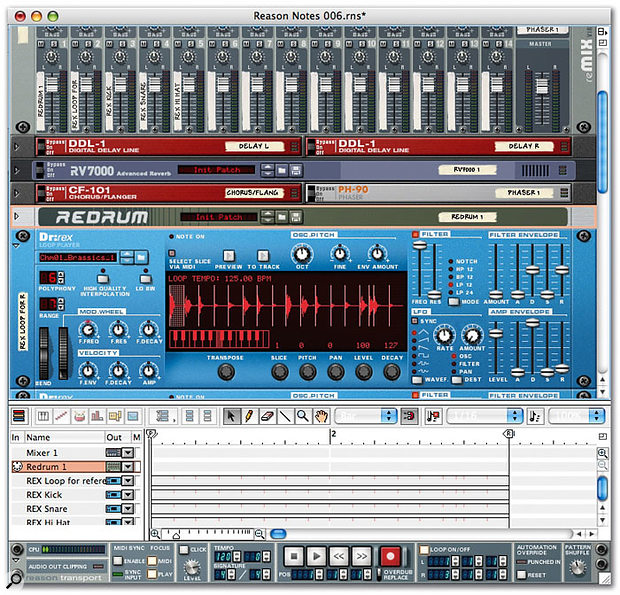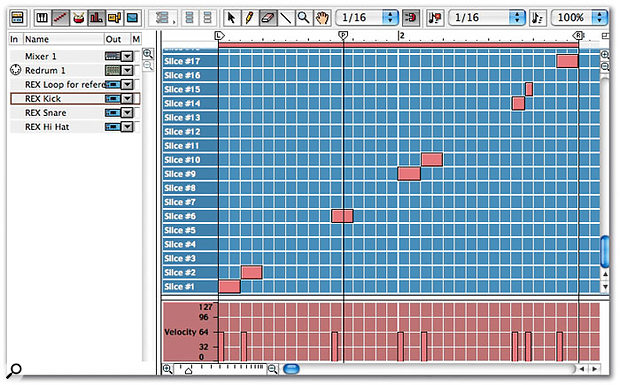 The initial rack, with Redrum and three instances of Dr:Rex, plus the 'To Track' events that trigger the loops' slices visible in the sequencer window.
The initial rack, with Redrum and three instances of Dr:Rex, plus the 'To Track' events that trigger the loops' slices visible in the sequencer window.
Ever loved the feel of a REX loop but disliked the drum sounds? Using Reason, you can steal the feel and substitute sounds of your choice with ease.
Practically since sampling first became available, recording engineers have employed tricks for isolating drum sounds and using them to trigger new samples — perhaps to replace a weedy original sound, make a mix more contemporary, or replicate the groove played on one drum kit with the (sampled) sounds of another kit.
Something like this technique can also be achieved in Reason. We'll be using REX2 loops, as generated by Recycle and played back by the Dr:Rex device. The objective is to steal the feel of a loop and assign new sounds loaded into a Redrum kit.
Quick Tips
In Subtractor, you can give two-oscillator bass sounds a different feel, and sometimes more edge, by enabling ring modulation with one of the oscillators tuned seven semitones (a fifth) higher than the other. A less thick sound is produced if you place the shifted oscillator one octave higher than the unshifted one.
You may not realise that Dr:Rex is polyphonic, since all it usually does is play back loops. But if, after 'To Track'-ing a loop, you highlight the slice triggers in the REX Lane and copy them — say, Alt-drag them a few 16th notes to the right — you'll enter a whole new rhythmic universe, with syncopations, rolls and fills appearing out of nowhere, depending on the source material.
Let's Begin
Start with a rack that's empty except for a Remix mixer. Add a Redrum, and then four instances of Dr:Rex.
- Click on the Browse Loop button of the first Dr:Rex and surf through the Factory Sound Bank Refill to the Dr:Rex Drum Loops folder. Now, take your pick: there's a lot of choice. Pretty much at random, I selected the first loop in the Chemical Beats folder (Chm01_Brassic_125_eLAB. rx2). It's kind of simple, loose and groovy in feel, with a nice bright kit. Of course, you could choose any loop you like.
- As this is a two-bar loop, for the purposes of this exercise let's set Reason 's right loop marker to the end of bar two and enable looping. Making sure that Dr:Rex 's sequencer track is also highlighted, press the device's To Track button. The triggers necessary to play back the loop have now been placed in the track, which you'll hear when you press Play on the main sequencer transport.
- Next, load the same loop into the remaining Dr:Rex 's and click on 'To Track' for each one. You could also simply Alt-Drag the data from the first track to the remaining three, to copy the Dr:Rex triggers to each track; the effect would be the same. I'd suggest that you name the sequencer track for the first Dr:Rex something like Main Loop — use this for reference later. Rename the other sequencer tracks: in this example, Kick, Snare and Hi-hat.
- This is where it gets mouse-heavy. Select the track labelled Kick, and go to the edit view, by clicking on the leftmost icon in the strip that runs above the main sequencer window; its tool tip will helpfully flash up 'Switch to Edit Mode.' Stretch the sequencer window so that you can see all the 'slice' triggers in the Dr:Rex lane, and zoom out so you just see the two bars of the loop. The slice number column to the left is our focus of attention, as we click on each entry to trigger the corresponding slice. There are 17 slices in this loop, and by auditioning each slice, you'll hear kicks, snare and hi-hats.
- In the Kick track, select the eraser from the tool bar and erase every slice that isn't a kick. You'll be OK if you make a mistake, since clicking entries in the slice list will still trigger the corresponding slice, even if the trigger in the lane has been erased. Now select the Snare track and erase every event that's not a snare. For the Hi-hat track, leave all the triggers in place. As you'll notice if you listen to the loop again, the hi hat plays on every slice.
 Focusing on the Dr:Rex 'Kick' track: all slices that aren't a kick drum have been erased.
Focusing on the Dr:Rex 'Kick' track: all slices that aren't a kick drum have been erased.
Cool For School
For a while now, Reason has been making inroads into education, a trend supported by Propellerhead's own Teaching Music With Reason (TMWR) package. In fact, Propellerhead have become a registered content provider to Curriculum Online (www.curriculumonline.gov.uk), a government-led entity that aims to improve access to ICT (Information & Communications Technology) and multimedia resources for all pupils. Secondary schools in England can use e-learning credits to buy TMWR from approved retailers.
Around At The Back
- Press Tab on your computer keyboard to access Reason 's back panels. Locate the Slice Gate Output socket on the 'Kick' Dr:Rex, click it and hold, drag a cable to the Redrum and connect it to the Gate In socket of Redrum 's channel one. This is generally a kick sound in most kits.
- From the 'Snare' Dr:Rex 's Slice Gate Output socket, drag a cable to the Gate In of Redrum channel two — a snare on most kits. The destination of the 'Hi-hat' Dr:Rex gate output depends on the Redrum kit. We'll drop it on channel nine's Gate In, because for this example we'll be choosing a kit where that assignment corresponds to a hi-hat sound.
- While you're still at the rear, you might want to disconnect the audio cables for the Kick, Snare and Hi-hat Dr:Rex devices from their Remix mixer inputs, since we don't want to hear their output. The Remix channels could be muted, but we're unlikely to want to hear those slices later, so disconnecting frees up Remix channels for other purposes.
- We're almost done: now hit Tab again to go to the front of the rack, then click on Redrum 's Browse Patch button. (I mentioned Tool Tips earlier, and these are really a lifesaver for newcomers: even if you're completely lost, simply using your mouse carefully causes these helpful little hints to flash up on screen.) I've chosen a kit for this example that seems as sonically opposed as possible to the original Dr:Rex loop — from the Factory Sound Bank again, find the Redrum Kits, go to the Hardcore Kits folder and choose Hardcore Kit 01. (Think Nine Inch Nails and a lot of distortion!) Pressing Play, all being well, should now audition the noisy kit playing the Dr:Rex loop, with its exact original feel, alongside the original loop. Mute Redrum and Dr:Rex to check out your work.
- With this technique, even the loosest, funkiest, most unquantised rhythm loops can be given the sound set of your choice. It may require a little ingenuity to isolate more than kick, snare and hat, but listen to the loop closely to see what can be picked out. For example, if there's a cymbal crash in there somewhere, figure out which slice it is and assign it to the cymbal of your choice.
 The back panel, where a Dr:Rex Slice Gate Output is linked to the Gate In of Redrum channel one. In our example, this will be loaded with a new kick-drum sample.
The back panel, where a Dr:Rex Slice Gate Output is linked to the Gate In of Redrum channel one. In our example, this will be loaded with a new kick-drum sample.
New Kits From Old Loops
Don't forget that the 'feel stealing' explained in the main text works both ways within Reason. Should you really like the individual drum sounds in a REX loop, load them into Redrum and make a new kit from them! The sample browser in Redrum, and all Reason sample devices, lets you go into a REX loop as if it were a folder and audition, and then load, the individual slices that make up the loop. The resulting kit will then have the sound of the original loop, but you'll be able to write whatever patterns you like with it.
Going Further
So far we've only dissected one loop. If you want to recreate more than one loop in a song you'll have to create more Dr:Rex devices and sequencer tracks for the loop slice triggers. This is unavoidable. But you only need one Redrum: using a Spider CV merging device, four Dr:Rex gate streams can be merged to one output (which would be routed to a Redrum channel).
You'll need one Spider CV for each class of slice trigger you're isolating, but once this wiring is done, the Spider CV devices themselves can be minimised and dragged to somewhere unobtrusive in the rack. Make sure that no actual merging occurs, though, unless you like the effect it produces. All you have to do is make sure that only one loop's kick, snare or whatever is playing at any one time.
Extending the Dr:Rex slice gate technique further, one could isolate rhythmic elements from the loop and use them to trigger Reason synths and samplers, adding textural changes that match the groove exactly. Another classic studio technique uses a noise gate to process a bass guitar, but triggers it from a kick-drum signal, so that bass and kick are completely tight and together. The same goes here: take a Dr:Rex Slice Gate Output connection to the trigger input of, say, a Subtractor or NN19 playing a bass patch. Write the notes for your bass line in an attached Matrix step sequencer, but use the Dr:Rex triggers to initiate the actual notes. Be prepared to play with amp envelope release times, since the triggers are very short. If this creates a bass line with too few notes — though this needn't be a bad thing — use the same technique to create a secondary bassline. Of course, the gate outs on each Redrum voice channel can also be used in the same way, to spread rhythmic integrity around the Reason rack.








